The ceremony is intended to invoke blessings for robust health and a plentiful yield of crops.
During the ceremony, up to three shamans and four assistants partake. The offerings comprise a pig, ten chickens, sticky rice, and a jar of wine.
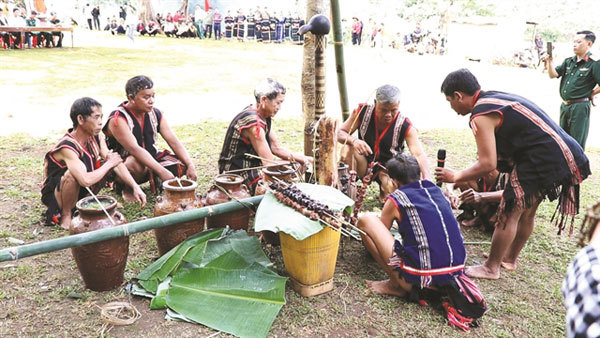 |
| Shamans and assistants at the ceremony. VNA/VNS Photos Quang Thai |
Every morning, residents convene at the central water source to make preparations for the event.
Once the pig and chicken have been slaughtered, the designated assistants carefully gather their liver, lung, kidney, tail, and wine to be placed on the sacred worship altar. Later on, the esteemed shamans and their dedicated assistants will commence the ceremonial rituals.
Worship Ceremony at Krêl Village
The main shaman will commence the ceremony with the following invocation:
“O Supreme Heaven, on this auspicious day, we gather here in Krêl Village to partake in a sacred worship ceremony.”
“At our establishment, we execute our duties with utmost sincerity. We are pleased to present our offerings, including a generous portion of roasted pork, ten succulent whole chickens, and a large container of exquisite wine.”
“We hope for the blessings of genies to provide us with a clean water source, good health, a bountiful harvest, and other valuable assets.”
“Dear valued visitors,
We kindly request your support in ensuring the safety of our community, as well as assisting us in achieving the same level of prosperity enjoyed by businesses in neighboring villages. Your patronage and protection are highly appreciated.
Warm regards,
The Management”
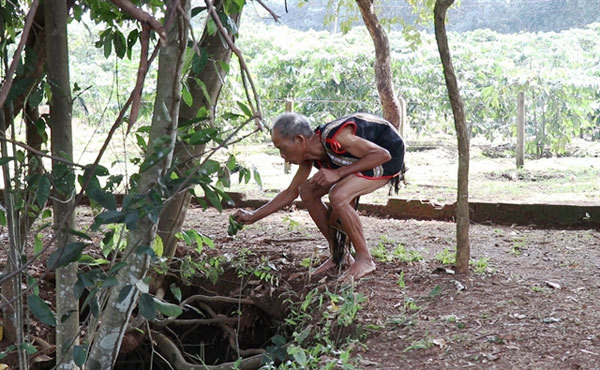 |
| An elderly shaman in practice. |
On the following day, local residents will carry out a traditional ceremony at the communal house, paying homage to the revered genies.
Nguyen Ngoc Long, the director of the theatre, remarked that it has been the venue for a multitude of traditional ceremonies since 2019.
“We have carefully selected the most distinctive cultural practices of the local ethnic minority groups to reinvigorate,” he explained. “Our endeavor focuses on reimagining the water source worship ceremony, in order to preserve and promote the rich tapestry of traditional values within the Jrai community, while cultivating a profound sense of patriotism and fostering their sense of pride.”
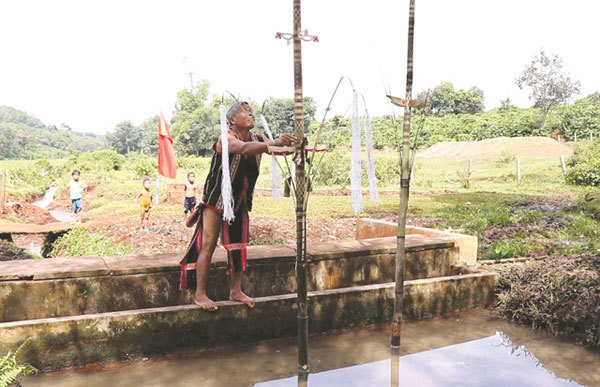 |
| The ceremony wishes for a bumper harvest and good health for everyone. |
According to Rơ Mah Che, a resident of Krêl Village, the community has been organizing the annual ceremony in October, albeit on a smaller scale.
“This year, the authorities have worked closely with us to meticulously plan the ceremony to adhere to our cherished customs, thereby bringing us immense joy,” he expressed satisfactorily.
Since the beginning of this year, the theater has successfully organized three significant ceremonies. These include the worshipping ceremonies for rain and a water source, which aim to strengthen the unity of the local community and uphold traditional customs.
“Ceremonies honoring the numerous spirits are a cherished tradition among the ethnic minority communities of the Central Highlands,” stated Long. “While these ceremonies may be organized within family or community settings, they convey a profound message of prosperity and joy to every individual and household.”
The Jrai people reside in rural villages, where each village accommodates approximately 50-70 households. Their traditional housing style involves living in stilted houses, with the main entrances facing the north direction.
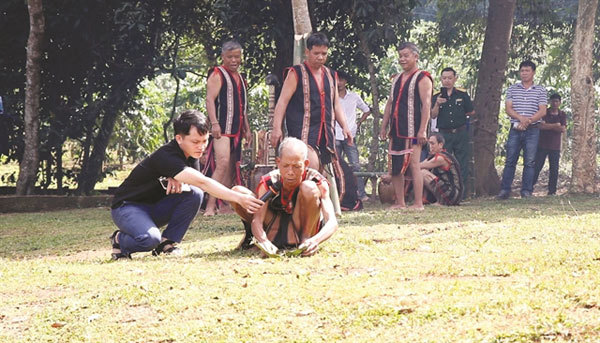 |
| Ancient procedures are kept in the ceremony. |
In the village, the male village head and elders hold esteemed positions and are responsible for overseeing the community’s affairs.
Every village is equipped with a communal house, with some villages having multiple community houses designated as “male” and “female” communal houses.
The communal house serves as a gathering spot for both locals and visitors, as it holds great significance in welcoming guests. Situated in the northern part of the village, it stands as a central hub for community activities.
The Jrai people primarily rely on agriculture as their main livelihood. They employ basic but effective farming tools such as knives and hoes. Additionally, they engage in poultry and cattle farming. Furthermore, they raise horses, buffaloes, and elephants. Buffaloes hold particular significance for the Jrai people, as they are utilized as offerings during religious ceremonies and can be exchanged for valuable objects such as gongs, jars, and copper saucepans.
Jrai men possess exceptional skills in crafting bamboo containers, while women excel in the art of weaving fabrics.
In addition, they engage in the activities of hunting and fishing as means of sustenance.
The Jrai people uphold a matriarchal system, wherein women have the liberty to select their partners and actively participate in marriage. Subsequent to the wedding, it is customary for the groom to reside in the wife’s familial home, with no property passed down to him from his own parents. In contrast, upon marriage, women have the option to relocate from their parental household and receive assets from their parents. Furthermore, it is customary for children to adopt their mother’s surname. However, societal norms prioritize men, assigning them a more significant role in the community.
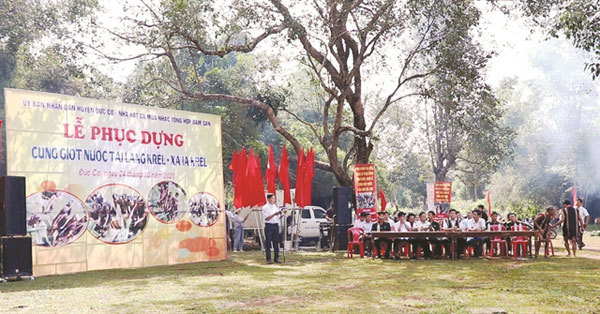 |
| The audience at the worship ceremony. VNA/VNS Photos Quang Thai |
The Jrai people are renowned for their rich tradition of storytelling, encompassing epics and legendary tales such as “Đăm Di Đi Săn” (Đăm Di Goes Hunting) and “Xing Nhã” (Life Story of Xing Nhã). Additionally, their cultural heritage includes the mastery of artistic forms such as gongs, drums, and the T’rưng bamboo xylophone.
The Jrai people possess exceptional talents in dancing and singing, which are nurtured from an early age and continue to flourish throughout their lives. Their mastery of these art forms is sustained well into their later years.



